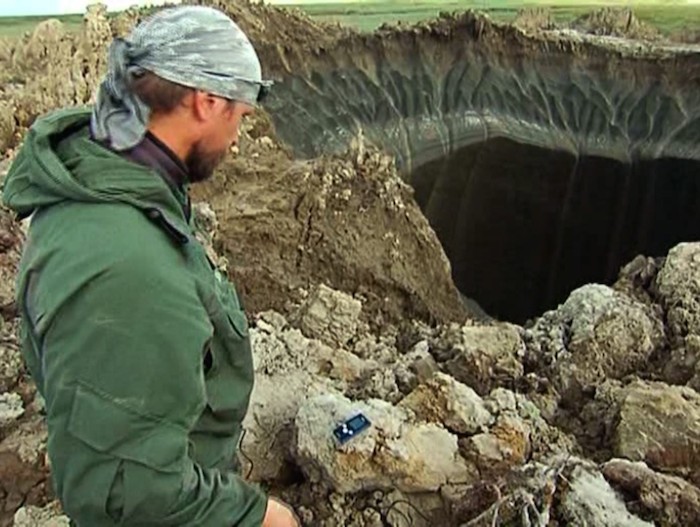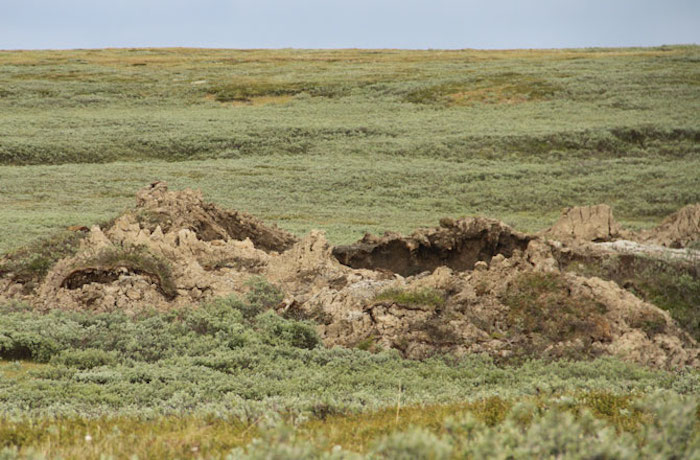.
15.07.2014

Meteorit, Explosion oder UFO? Riesiges Loch am Ende der Welt gibt Rätsel auf
.
Im abgelegensten Winkel von Sibirien gibt ein Loch im Boden Rätsel auf. Niemand kann erklären, wie es entstanden ist. Theorien reichen von einem Meteoriten-Einschlag bis zu einem UFO-Absturz. Am wahrscheinlichsten ist jedoch eine Methangasexplosion.
Im Norden Sibiriens, in der Region Yamal, fernab jeglicher Zivilisation, ist am Boden ein Riesenloch entdeckt worden, wie eine lokale Zeitung berichtet.
Luftaufnahmen zeigen das mysteriöse Loch, dessen Grösse Experten auf ungefähr 80 Meter schätzen.
Ein Forscherteam reist jetzt nach Sibirien, ans «Ende der Welt», wie das Gebiet auch genannt wird, um das Loch zu erforschen. Denn noch ist unklar, woher dieses stammt. Ist es ein Meteoren-Krater?
«Definitiv nicht», widerspricht hier ein russischer Kabinettssprecher. Stammt das Loch von einer Methangas-Explosion, geschuldet der globalen Erderwärmung? Dies die naheliegendste Theorie.
Eine weitere besagt, das Loch stamme von einem UFO. Schauen Sie das Video und urteilen Sie selbst.
Am Mittwoch sollen die Forscher in Sibirien ankommen. Sie wollen Proben aus dem Boden, vom Wasser und der Luft nehmen und so herausfinden, woher das grosse Loch stammt.
Video: https://www.youtube.com/watch?v=2kMs05VaOfE#t=21
.
Quelle: Aargauer Zeitung
.
Update: 19.07.2014
.
Woher kommt dieser mysteriöse Krater?
Forscher haben in Sibirien einen riesigen, mysteriösen Krater entdeckt. Ein Meteorit war es nicht. Aber ist ein UFO dafür verantwortlich?

Entdeckt wurde der mysteriöse, kreisrunde Krater bei einem Hubschrauberflug über der sibirischen Tandra auf der Halbinsel Jamal, was übersetzt so viel wie „Ende der Welt“ bedeutet.
Der Pilot schätzt den Durchmesser auf 80 Meter. Die Tiefe ist noch unbekannt, der Boden war nicht zu erkennen. Derzeit befinden sich laut „Siberian Times“ Wissenschaftler auf dem Weg zum Krater, um ihn genauer zu untersuchen.
Das Video der Loch-Sichtung wurde auf YouTube schnell zu einem Hit – und beflügelte die Fantasie der Betrachter: Eine UFO-Landung als Entstehungsgrund wurde natürlich auch diskutiert.
Etwas wahrscheinlicher ist da die Theorie der russischen Wissenschaftlerin Anna Kurshatowa. Sie hält es für möglich, dass der Krater entstand, weil sich ein Gemisch aus Wasser, Salz und Gas unter der Erde entzündet hat. Schuld sei die Erderwärmung: Durch das Auftauen der Permafrostböden werden große Mengen Gas freigesetzt. Der Effekt sei vergleichbar mit dem Ploppen eines Sekt-Korkens.
Der australische Polarforscher Chris Fogwill machte im „Sydney Morning Herald“ das Abschmelzen eines Pingo für das Loch verantwortlich. Ein Pingo bezeichnet einen unterirdischen Eisberg im Permafrostboden.
Immerhin ist eine Ursache schon mal ausgeschlossen: „Wir können definitiv sagen, dass es kein Meteorit war“, sagt ein Sprecher des russische Katastrophenschutzministeriums.
Quelle: BZ
.
Update: 27.12.2014
.
Mystery Siberian Crater: Rappelling Over the Edge

Just what created the massive, yawning craters on the Yamal Peninsula in northern Siberia? This week scientists decided to dive into one to find out.
Using climbing equipment, scientists from Russian Center of Arctic Exploration plunged 54 feet into one of the massive chasms.

"We managed to go down into the funnel, all was successful," mission leader Vladimir Pushkarev told the Siberian Times. "We used climbing equipment, and it is easier to do this in winter, than in summer, with the ground now hard."
The first of the craters was discovered in mid-July, by reindeer herders on the Yamal Peninsula (the name means "end of the world.") Since then two other chasms in the same region were also reported.

At the bottom of the crater is a lake that scientists estimate is about 34.4 feet, or 10.5 meters deep.

During their descent, scientists took samples of ice, soil, gasses and air.
With their data now stashed and transported to various institutions, the researchers will work on finding explanations for the formation of the mysterious craters.

One theory behind the craters' formation is gas hydrates. When permafrost melts, gas is released, causing an underground explosion. Gasses -- including methane -- are found trapped in frozen hydrates below the permafrost.
Scientists hope data from the recent expedition will offer definitive explanations.
---------
Rückblick Juli 2014

A second massive crater has appeared in a remote part of Siberia on the Yamal Peninsula, called "the end of the world." The new crater was discovered by reindeer herders about 30 kilometers (19 miles) from the first, reports the Moscow Times. Following this discovery, a third hole was found to the east of the other two. It's just 15 meters deep but 60-100 meters deep, locals report.

It's uncertain yet what's caused the sinkholes, but experts said global warming may play a part. Above is a view of the wall inside the first crater.

One theory: when permafrost melts, gas is released, causing an underground explosion.

Experts from the Center for the Study of the Arctic and the Cryosphere Institute of the Russian Academy of Sciences have studied the hole, returning with the first photos from the site.

"We can definitely say that it is not a meteorite," a spokesman from Russia's Emergencies Ministry told the Siberian Times.

The area contains some of Russia's most plentiful stores of natural gas. About 10,000 years ago, the area was under the sea, which left salt deposits.

The first hole is about 50 meters wide (164 feet, or about 15 stories) and 70 meters deep (229 feet, about 21 stories), reports the Moscow Times. The second appears similar, but is much smaller.
Scientists are concerned that global warming could cause more permafrost melt, which could release methane, a greenhouse gas -- and possibly more enormous Siberian sinkholes.
.
Quelle: D-NEWS
7152 Views
